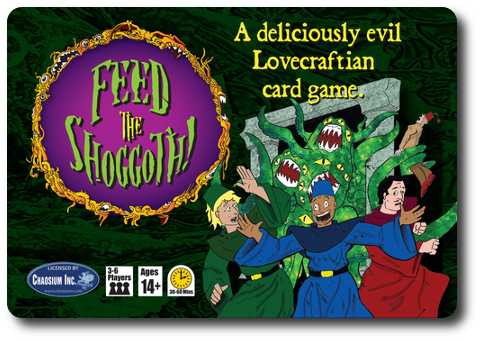
The Basics:
- For ages 8 and up (publisher suggests 14+)
- For 3 to 6 players
- Approximately 45 minutes to complete
Geek Skills:
- Active Listening & Communication
- Counting & Math
- Logical & Critical Decision Making
- Reading
- Strategy & Tactics
- Risk vs. Reward
- Hand/Resource Management
- Bluffing and Misdirection
Learning Curve:
- Child – Easy
- Adult – Easy
Theme & Narrative:
- Being a Cult Leader is hard…
Endorsements:
- Gamer Geek approved!
- Parent Geek mixed!
- Child Geek mixed!
Overview
Influential horror fiction author H.P. Lovecraft said, “Bunch together a group of people deliberately chosen for strong religious feelings, and you have a practical guarantee of dark morbidities expressed in crime, perversion, and insanity.” In this game, each player is the leader of an underground cult who is attempting to be the first to summon a Shoggoth, which is an altogether bad idea. Seriously bad.
Feed the Shoggoth!, designed by Badger McInnes and published by Squamous Studios, is comprised of 72 Play cards (comprised of Spells, Artifacts, and Actions), 36 Minion Cards, 10 Cult Faction Cards, 1 Shoggoth Card, and 1 Graveyard Card. The cards are as thick and as durable as your standard playing card. The illustrations, also by the game designer, are heavily influence by both H.P. Lovecraft and the Call of Cthulhu RPG, with a good bit of tongue and check, too. After all, if we can’t laugh in the face of cosmic horrors and elemental madness, why bother getting out of bed in the morning. Not included in the game, but necessary to play, are small counters or a pen or pencil and some paper to keep track of players’ scores.
Preparing for the Ritual
To set up the game, first find and place the Shoggoth card in the middle of the playing area.
Second, shuffle the Cult Faction cards and deal 1 to each player, face-up. You can optionally allow players to select their own Faction card, but I find this takes too much time. Once each player has a Faction card, place the remaining Faction cards back in the game box.
Third, find and set aside the Graveyard card and shuffle the remaining cards. Deal 7 cards to each player, face-down. Players can look at these cards, but should keep them hidden until played. Each player should have at least 1 Minion card in their hand. If they do not, deal them another hand of 7 cards. Place the remaining undealt cards face-down to one side of the game playing area. This is the draw deck. Place the Graveyard card next to it and leave room for a second discard pile.
That’s it for game setup. Determine who will go first and begin.
Forbidden Magic for Fun and Profit
Cult Leaders have a wide variety of dark and disturbing things at their disposal. Ancient magic, lost knowledge, and artifacts that are capable of destroying the world and making popcorn. Having a brief summary of this occupation is essential to a Cult Leader’s survival.
The Cults
Each Cult Faction card represent 1 of the powerful secret societies that pull the strings of the world. Each Cult Faction goes about manipulating humanity (and other things) in slightly different ways, but most of their methods are universally similar. What is not is the specific perk available to the Cult Faction. A Cult Faction card might give its holder a special ability they can use per turn or grant immunity from certain card effects. No single Cult Faction is greater than the other, but players should keep in mind that their perk gives them a slight advantage.
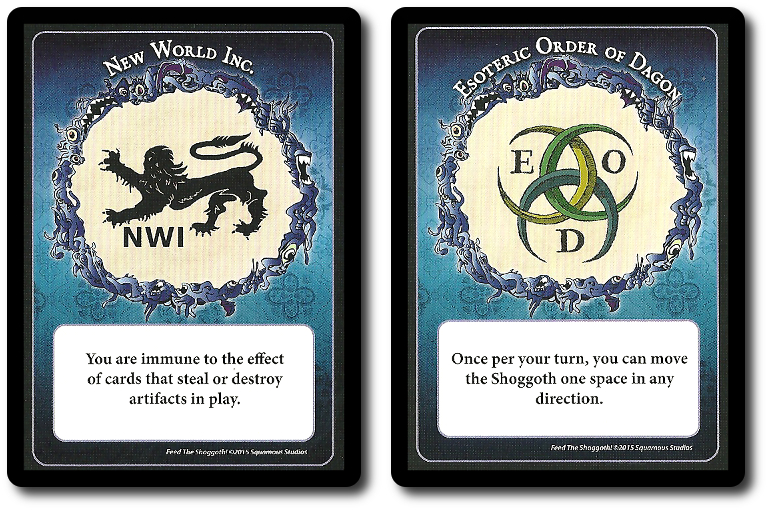
The Shoggoth!
This big slimy thing, writhing with tentacles, has entered our world. Consequentially, the cross-dimensional trip has made it very hungry and cranky. Minions must be popped into the Shoggoth’s mouths every 2 minutes. Feed it enough, and all will be well. Unfortunately, others have summoned the Shoggoth and are also feeding it. This creates something of a conflict of interest.
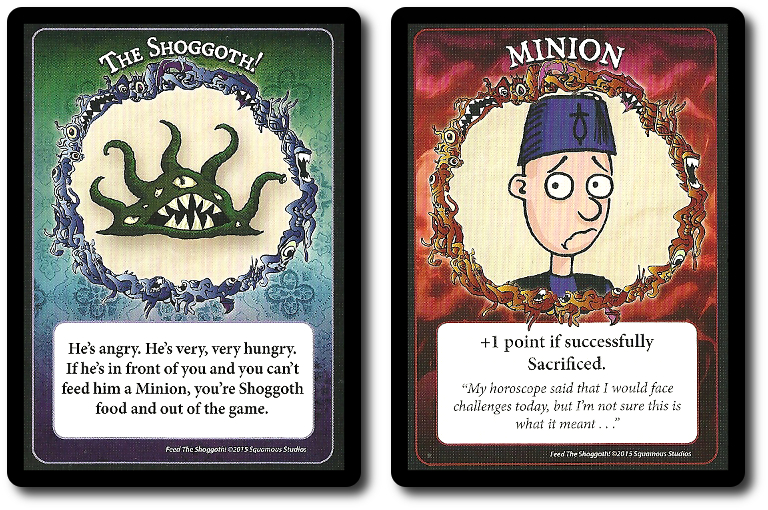
Magic
Magic is hard to describe. It’s one part leap of faith and one part leaping off a very high cliff. Magic is old and not well understood, but that has never stopped people from using. Magic can be cast at anytime by the player, be it their turn or not. Magic appears to be designed to either help or hinder, but never in a way that ends well.
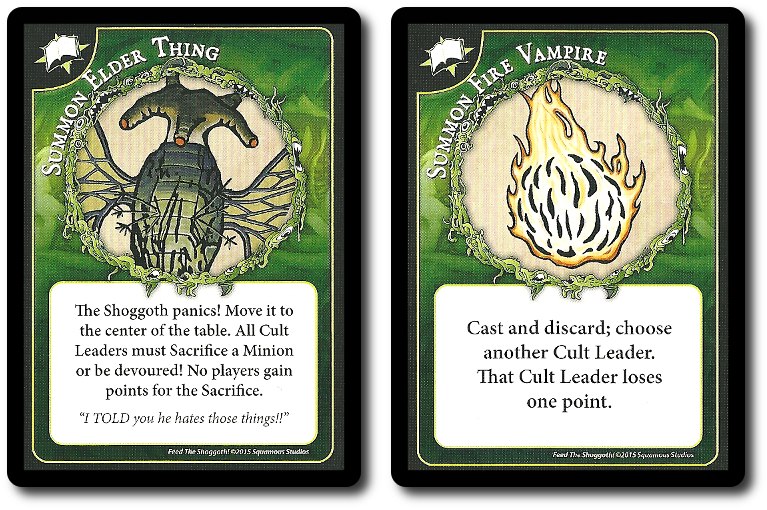
Artifacts
One of the more unfortunate side effects of mixing magic with everyday objects is the creation of things that are very dangerous. Powerful, destructive, and normally given names that are both descriptive and confusing, Artifacts are objects of great power. If a gunfighter always has a gun, a Cult Leader always has an artifact. Normally around their neck, but sometimes on their hip.
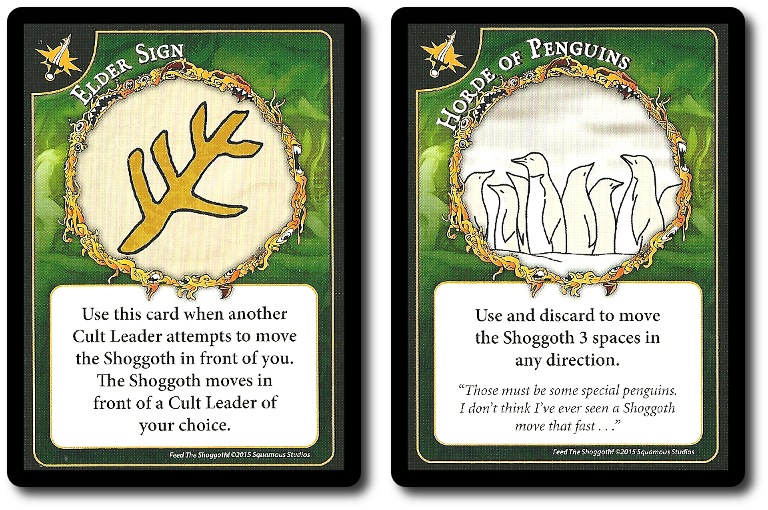
Actions
Action cards are similar to Spell cards, but they don’t use magic. As a result, Action cards cannot be blocked or canceled. One must wonder why actions aren’t used more, especially when they are almost always successful. The answer is simple: actions aren’t magical and magic is cool.
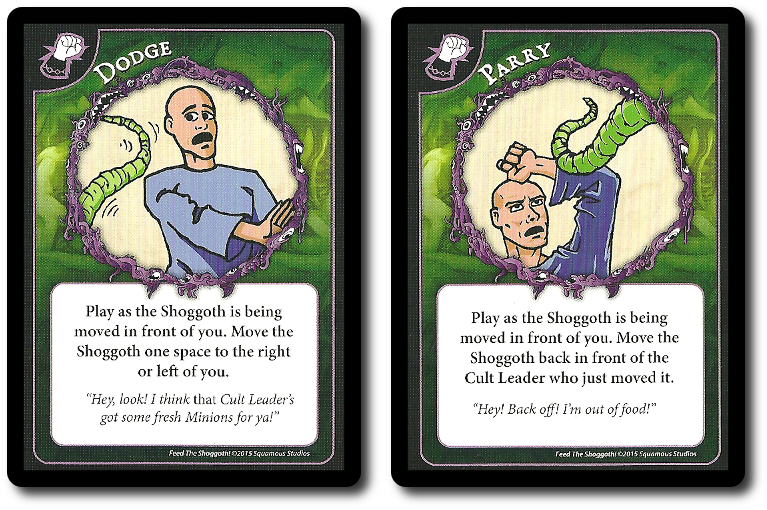
The Ritual Begins!
Feed the Shoggoth! is played in turns with no set number of turns per game. A player’s turn is summarized here.
Step 1: Play Artifacts
If the player has any Artifact cards in their hand, they can play them face-up now. When placed, they should be tipped to one side to visually indicate that they are in play, but not yet available to use. While it might seem wise to play as many Artifacts as possible, players should keep in mind that cards can be stolen and destroyed by opponents.
Step 2: Activate Artifacts
Any Artifacts previously played and are still tipped to an inactive state are now tipped back to an active state (normal card placement) to indicate they can be used. It’s important to remember that Artifact cards played this turn CANNOT be activated until the next turn. As such, players need to plan ahead in regards to when they want to use the Artifacts in their possession.
Step 3: (Optional) Feed the Shoggoth!!!!!
If the Shoggoth card is in front of the player, they can declare they will be feeding it. The assumption here is that the player has a Minion card in their hand, but like all assumptions, there is little to no proof to back it up. Tactically speaking, it would be exceedingly entertaining to have opponents spend resources to stop an action that was never going to take place. Weakening an opponent just a little can allow the player to win the game or survive just a little bit longer.
Once a declaration is made that the player will feed the Shoggoth, the player’s turn enters what is referred to as the “Sacrifice Phase”. This is just a fancy way of saying all opponents can now mess with the player. Cards can be used against the player to end their turn abruptly, move the Shoggoth card, and about a dozen other ways to make the player’s turn painfully unproductive. Ironically, the only thing safe from being targeted by negative effects is the Minion card slotted to be sacrificed to the horrific nightmare hungrily smacking its lips.
Of course, if the Shoggoth card is not in front of the player, the first order of business is to get its attention. This is done by moving the Shoggoth card by use of Spells and other unsavory techniques. The player announces their intentions, reveals the card that will do the job, and then politely waits for the opponents to make a mess of things. While moving the Shoggoth is not the start of the Sacrifice Phase, opponents are given an opportunity to thwart the Shoggoth’s movement.
The player is not without means of protecting themselves, their assets, and their intentions. When an opponent plays a card on the player, they have an opportunity to block, redirect, or cancel it with their own cards. This step in the game can be very chaotic, so it’s customary to always pause for a moment to allow opponents to determine if they want to stop or block cards. In turn, the player is also shown the same courtesy and only 1 card is played on them at a time.
If by some miracle the opponents are not able to stop the player from tossing a Minion into the Shoggoth’s 12 stomachs, the player places their Minion card to the Graveyard (this Minion is out of the game), scoring 1 point for the player. The Shoggoth card is then placed in front of the next player in turn order sequence.
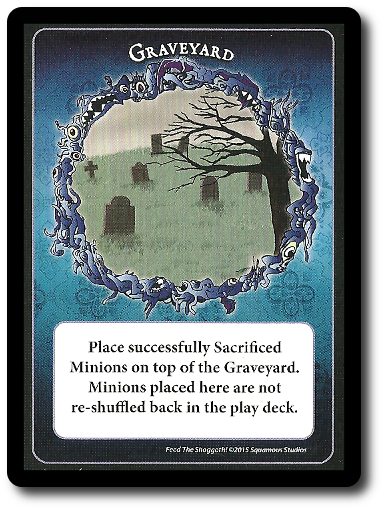
However, if the Shoggoth is in front of the player and they do not have a Minion card or the means to move the Shoggoth, then the Shoggoth eats the player’s Cult Leader. The player is now out for the duration of the game. The Shoggoth, burping contentedly, is then placed in front of the next player in turn order sequence. The only exception to this rule is if the player has lost their turn and is unable to feed the Shoggoth. In which case, the Shoggoth sympathizes (sort of) and politely waits for the player’s next turn to devour him.
Step 4: (Optional) The Stars Are Not Right
Optionally, the player can skip steps 1 and 3. The player can discard any number of cards from their hand and then draw back up to no more than 7 cards. If the player takes this action, they are also safe from the Shoggoth for their turn. Well, safe’ish. The Shoggoth will not move towards the player, but if the Shoggoth is already in front of the player, it will feel rather put out that it’s not being fed, become cross, and eat the player’s Cult Leader. As such, this step is seldom taken (for good reasons) when the Shoggoth card is in front of the player.
Step 5: (Optional) This is Crazy
Finally, if the player really wants to, they can just reset any tipped Artifact cards and call it a day. The player ends their turn and no other actions can be taken. However, if the Shoggoth is in front of the player, it will eat the player’s Cult Leader.
Step 6: Ending of Turn
Regardless of what steps the player took, at the end of their turn, they draw back up to 7 cards. It’s now the next player’s turn to get eaten.
Out of Turn Shenanigans
Even though it may not be the player’s turn, they are still very much an active participant in the game. Many cards allow players to muck up the works and cause a great deal of trouble. Players can use thee Spells at anytime during the game unless the card specifically says otherwise. Some cards are in response to other cards and some can be played “just because”. In all cases, playing a card out of turn is optional. Once played, it’s sent to the discard pile (not the Graveyard). When played out of turn, the player does not draw a card to replace it. As such, it’s wise for a player to not play too many cards or they risk leaving themselves open to reprisal.
Lord of the Shoggoth
The game continues until 1 player scores enough points to win (determined by the number of players in the game) or only 1 player’s Cult Leader remains uneaten.
Game Variants
For a longer and more tactical game, increase the required number of points to win by +2. This will force all the players to think more long-term, play more efficiently, and be much more cutthroat. It’s only a matter of time before the Shoggoth eats a player and increasing the Shoggoth’s opportunity to do so will certainly make each player much more interested in playing with a more defensive stance.
If players are really looking to take some punishment, they can use the optional rule that states that feeding the Shoggoth is not optional, regardless if it’s the player’s turn or not. This means an opponent can move the Shoggoth in front of a player during their turn and force them to feed the Shoggoth. If they can’t? Chomp.
To learn more about Feed the Shoggoth!, visit the game’s website.
Final Word
About half of the Child Geeks we played with knew what the game was all about, while the other half just thought the game was about feeding a monster. Close enough. The Child Geeks liked the fast paced action of the game, but not the chaos that derived from it. According to one Child Geek, “It’s easy to play, but I don’t like how fast the cards can be placed and then resolved. It’s hard to keep track of.” We slowed the game down as fast as we could to help the less experienced Child Geeks, which helped a great deal. By doing so, however, we made the game boring. As one Child Geek put it, “This game needs to be played fast. It needs to be played crazy. This game is like Hot Potato with a cosmic nightmare.” Which describes the game very well, especially the Hot Potato part. The Child Geeks were split when it came time to deliver their votes for approval. Those Child Geeks who were more experienced voted to approve Feed the Shoggoth!, while all the rest decided to let the Shoggoth starve.
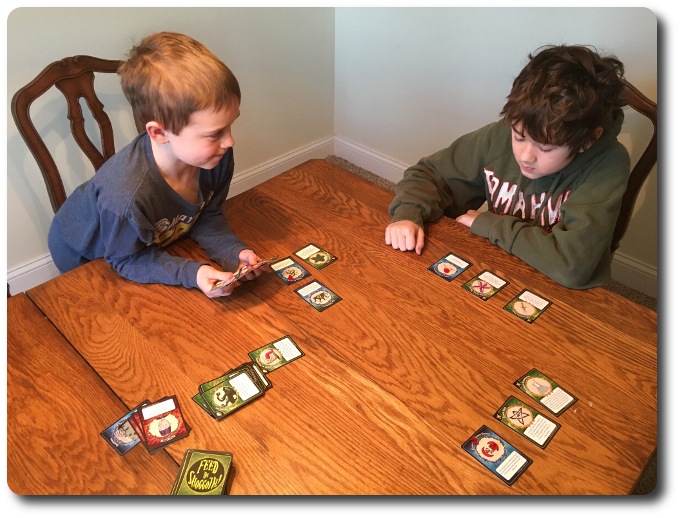
A younger brother leans forward, ready to pounce on his older brother’s card…GOOD TIMES!
The Parent Geeks were very similar to the Child Geeks when it came time to respond to the game. The casual and inexperienced players found Feed the Shoggoth! to be too chaotic and misdirected at times, meaning cards moved to fast. According to one Parent Geek, “I sort of know the backstory of a Shoggoth, but that really doesn’t do anything for the game. What I don’t care for is how hard it is to simply score a point when everyone is messing with you.” More experienced Parent Geeks really enjoyed the game, finding the “messing with other players” game play to be engaging, exciting, and nail-biting. As one Parent Geek put it, “There is nothing worse in Hell, Heaven, or Earth than being eaten by a Shoggoth, especially when you only needed 1 more point to win.” After the Shoggoth was stuffed back into the portal, the Parent Geeks gave Feed the Shoggoth! a mixed approval. The only thing the Parent Geeks did agree on was that Shoggoth was an insufferable bastard.
According to one Gamer Geek, “This is a total beer and pretzels game. I love it. Great theme, interesting player interaction, and of course, there’s Cthulhu.” I was surprised that the Gamer Geeks overlooked the game’s chaotic nature. I thought for certain that the constant back and forth card plays with near infinite interruptions would cause their heads to explode. Not the case. As one Gamer Geek put it, “The game is fast and you have to keep thinking about what you need to do to survive just one more round. That’s where the real fun comes into play. When you understand the game is about survival at all costs, it becomes awesome.” When all the games were over, the Gamer Geeks loved the chaos, finding the game to be maddeningly entertaining.
The Shoggoth is a servitor race created by the Elder Things. The Shoggoth are, in effect, slaves. At least, that was their original purpose. The Shoggoth rebelled, in a fashion, and the results were a tenuous relationship at best between master and servant. It’s still in the Shoggoth’s nature to be subservient, however, which is why it’s a popular horror to summon. Only slightly less intelligent than your average Cult Minion and a thousand times stronger, the Shoggoth can be a tremendous boon to anyone mad enough to summon it. However, there is a catch. The Shoggoths are hungry and demanding, much like a 6-year-old child. They don’t care who or what it’s given to eat as long as it gets it right now. Many Cult Leaders forget this or underestimate the ferocity of the Shoggoth’s appetite. Scholars believe this is why entire Cults will go into a building in the evening and not a single one will come out the next morning.
I am such a geek…
This is a game that’s perfect for one thing and one thing only: killing time whilst cursing. Feed the Shoggoth! has so many twists and turns, amazing comebacks and spectacular downfalls that the game often feels like a dark satirical soap opera rather than a card game. It all comes down to the way players interact with each other. Everything is geared to do one of two things: get eaten or get someone else eaten. The entire time I was playing it I kept thinking, “If Mel Brooks ever made a movie based on H.P. Lovecraft, this would be it.” Dark slapstick disparaging humor at its finest.
Theme and game play blend together nicely. Nothing feels pasted on and every card represents something of value to the player. The only aspect of the game that will become confusing and sometimes needs a flowchart to navigate is the resolution of cards. The game rules briefly discuss the concept of “first in, last out” to resolve Spells and Artifacts, but it can get confusing to determine who needs to block and the aftereffects thereof. Not terribly confusing, mind you, as all it takes is a little bit of creative thinking to determine the best course of action, but it’s no walk in the part when 5 players drop Spells and Artifacts on you roughly around the same time. Arguments might ensue.
I somewhat agree with the Gamer Geek that suggested this was a “bear and pretzels” game. It’s light, random, and loaded with humor. It can also be tactical and take well over 30 minutes, which is not normally noted as a characteristic of the “beer and pretzel” games. Instead, I’d suggest Feed the Shoggoth! is a “beer and burger” kind of game. It’s still light, but it’s also heavy enough to satisfy a player with a single game.
Funny, fast, frustrating, and feverish, Feed the Shoggoth! challenges the player to dodge certain doom by passing it on to others. All the while, the only way to make points is to stick yourself directly in harm’s way. Victory is not given to the bold or to the foolish, but to the lucky. Everyone else gets eaten. Do try Feed the Shoggoth! when time permits, but be prepared to feel a bit chewed up.
This game was given to Father Geek as a review copy. Father Geek was not paid, bribed, wined, dined, or threatened in vain hopes of influencing this review. Such is the statuesque and legendary integrity of Father Geek.



